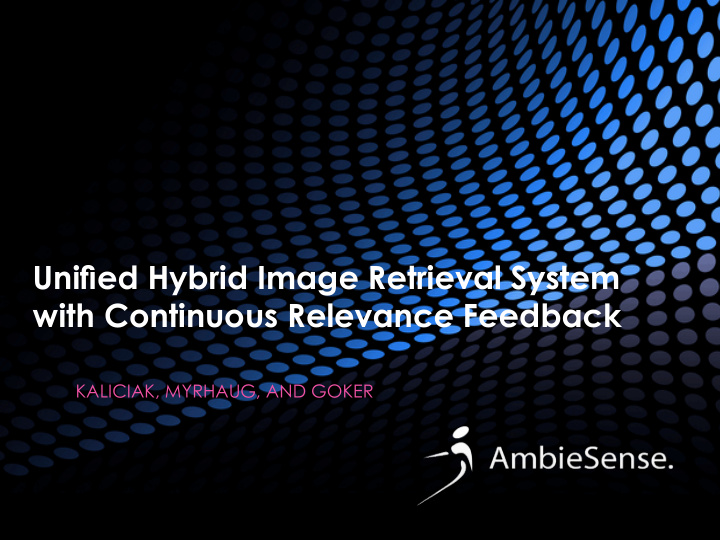



Unified Hybrid Image Retrieval System with Continuous Relevance Feedback KALICIAK, MYRHAUG, AND GOKER
Content Image Retrieval Vector Space Model, Visual Example, similarity measurement, hybrid models - data fusion Visual Features: low-level, mid-level, high-level Proposed unified system System components User interface Spin-off hybrid models and continuous relevance feedback Unified system in use - example
Image Retrieval Usually based on Vector Space Model Visual content and image tags represented as vectors Query represented as vector Angle or distance between vectors -> similarity Top ranked images presented to user (based on similarity scores) 𝑏|𝑐 𝑡𝑗𝑛 𝑏, 𝑐 = 𝑏 ∙ 𝑐 𝑏 𝑗 − 𝑐 𝑗 2 𝑡𝑗𝑛 𝑏, 𝑐 = 𝑗
Global Visual Features – low-level
Visual Features – mid-level (+) some ability to recognize objects (-) visual words have no semantic meaning
Visual Features – high-level Grouping of visual words Segmentation-based (+) closest to human perception (-) not yet scalable to large data collections and generic image retrieval
Unified Image Retrieval System Various visual features and their combinations Combination of visual and textual feature spaces Combination of visual and textual feature spaces in the context of search refinement Interactive user interface with user relevance feedback Relevance with continuous degrees of relevance Exploratory search Query history Positive and negative results panels
Image representations and their combinations Visual features: edge histogram homogeneous texture bag of visual words features colour histogram co-occurrence matrix Combinations of the above
Hybrid models Hybrid models Hybrid relevance feedback models For re-scoring For re-ranking Hybrid adaptive relevance feedback
Hybrid models and tensor product Fusion of feature spaces improves the retrieval results in general We use tensors to fuse the feature spaces and to capture correlation and complementarity between them Feature space A Feature space B Intra-correlations Inter-correlations
Adaptivity of Hybrid Models We measure the strength of the relationship between query and its context Weak relationship - context becomes important. We adjust the probability of the original query terms; the adjustment will significantly modify the original query Strong relationship - context will not help much. The original query terms will tend to dominate the whole term distribution in the modified model. The adjustment will not significantly modify the original query
Interactive User interface with User Relevance Feedback, Relevance with Continuous Degrees of Relevance, Exploratory Search, Query History Positive and Negative Results
Thank you
Recommend
More recommend